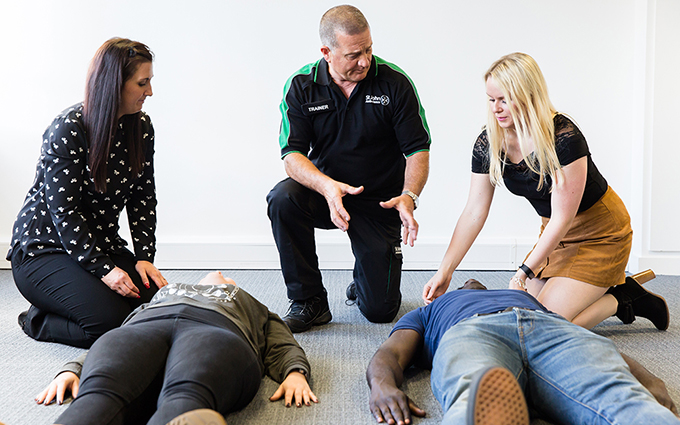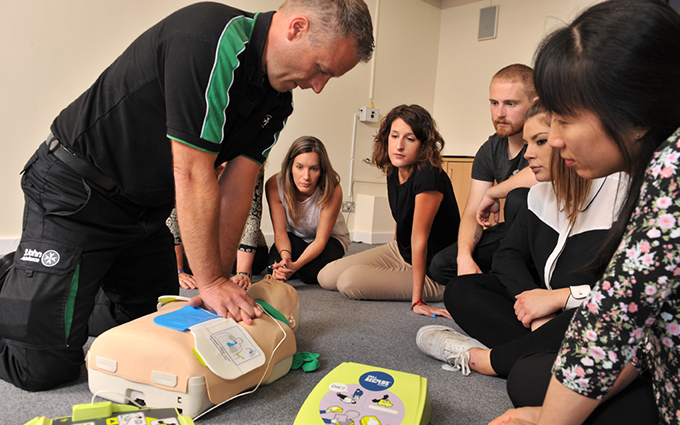Published: 27th October 2025.
Last updated: 27th October 2025.
Author: Cara Sherratt.
Contents

Crispy leaves and cold snaps have descended upon us at a seemingly record speed this year. As whispers of “are you putting the heating on yet” whisked through office chats with our transition from record-breaking summer days into the chills of autumn entering at a record pace as soon as the calendar hit September.
Now, halfway through October we are in full swing of the autumnal air and therefore in need of reminding ourselves that along-side the cosy vibes of this time of year, there are new hazards lurking at every corner.
Just as summer brings an increase in seasonal injuries related to hot weather and outdoor cooking, these colder and wetter seasons also have their unique dangers to keep your first aiders busy. So, what should we be more careful of throughout the autumn months and what supplies should we be checking our expiry dates on and ensuring we keep stocked up to cater for the increase in slips, trips, burns, chills and even, explosions?
Read through our quick guide to seasonal hazards and injuries to ensure you are prepared for upcoming weather and events as well as having all the right supplies to treat common autumnal dangers.
Dangerous Roads, Gardens and Walkways
To avoid injuries from dangerous roads, gardens and walkways, be wary of the following hazards: Wet weather, falling leaves, gusty weather moving debris, frost, overexertion, improper technique and reduced visibility when driving.
Potential injuries may include the following: Blisters, back strain, muscle cramps, sprains, fractures, punctures (from garden tools), crushing and bruising.
For this, your first aid checklist should include:
- Blister pads or hydrocolloid bandages
- Muscle rub or pain-relieving cream
- Elastic support wrap
- Heat patch or packs
- Rehydration salts or water (for cramp prevention)
- Joint Supports
- Bandages
- Antiseptic wipes
- Hand or head torch
Chills, Colds and Frosty Weather
To minimise the effects of chills, colds and frosty weather, be sure to look out for: Temperature dropping, improper weather preparation, transition in clothing, increased wet weather with cold temperatures, introduction of hail, sleet and frost.
Potential effects could include the following: Hypothermia, frostbite, or early signs like chilblains, headaches and an increase in the negative effects of alcohol.
For this, your first aid checklist should include:
- Emergency thermal blanket
- Hand warmers
- Dry warm clothing or socks
- Instant heat packs
- Insulated gloves and hat
- Thermometer (to monitor body temperature)
- Lozenges or throat spray
- Decongestant
- Tissues
- Hand sanitiser
Bonfires, Fire Pits and Burns
Potential causes of accident, injury and illness during bonfire seasons exist as follows: Seasonal traditions, removal of old wood, keeping warm outside (heaters/fires), marshmallow toasting, candles, cooking, indoor fireplaces and poor ventilation.
First aid casualties from fire pits, burns and bonfires include: chemical burns, minor or major burns, surface wounds, splinters, carbon monoxide poisoning, headaches, dizziness, smoke inhalation.
For this, your first aid checklist should include:
- Burn gel or burn dressings
- Non-stick sterile dressings
- Cold compress or clean cool water
- Pain relief medication
- Disposable gloves (for hygiene when treating burns)
- Plasters
- Antibacterial cleaning wipes
- Tweezers
- Burn information posters
- Blister pads
- Carbon monoxide detector (preventive)
- Fire alarm
- Fire equipment eg. Fire blankets or extinguishers
- Emergency numbers available
Slips, Trips, and Falls
Causes and hazards for trips, slips and falls this autumn are: Darker evenings, wet weather, leaves falling, uneven ground, mud, frosty driveways, windy / gusty weather and wearing improper footwear.
Injuries may include: Bruises, scrapes, fractures, breaks, sprains and wet feet.
For this, your first aid checklist should include:
- Ice packs (for swelling)
- Elastic bandages (for sprains)
- Adhesive bandages (for minor cuts)
- Antiseptic wipes (for cleaning scrapes)
- Sterile gauze pads and tape (for deeper wounds)
- Pain relievers (e.g., ibuprofen)
- Hand or head torch
- Shoe grips / proper footwear
Fireworks and Bonfire Night Events
Things to look out for when celebrating bonfire night, or watching fireworks: Prolonged time outside, exposure to chemicals, close contact to heat and fire, reduced visibility and pedestrian accidents, contact with moving vehicles in dark evenings, wet underfoot terrain.
Potential injuries could be obtained from: Unknown weather conditions and busy areas. These could cause an array of accidents and injuries that are worth staying prepared for. These can include heat or chemical burns, impact traumas, fractures or broken bones, bruises, sprains, blisters, cuts and scrapes.
For this, your first aid checklist should include:
- A fully stocked and in-date first aid kit
- Miniature, travel-sized first aid kit
- Reflective clothing or flashlight (preventive)
- First aid or fleece blanket
- Wound dressings
- Triangular bandage (for arm support)
- Emergency contact card or phone
Be prepared and stay prepared with the turn of the seasons. We all hope that accidents and injuries won’t happen to us, but you can never guarantee safety. Stay alert and make the most of the supplies that can help to prevent, treat and avoid causing further harm during shorter days, darker evenings and colder weather.
Enjoy the cosy seasons, seasonal events and festivities – safely!
















